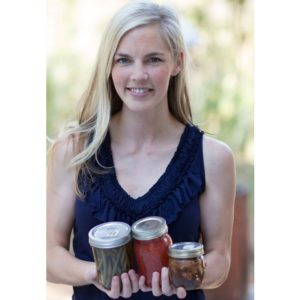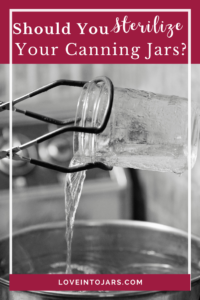This post will explain why you don’t need to sterilize your jars before canning- except when you do. Read on for the scoop!
Sterilizing jars before canning is topic I’m asked about often and I wanted to write a post to clarify when sterilizing jars is necessary when canning, and when it is not.
One of the factors that makes canning “work” is heat. Water bath canning brings the inside of the jars (and thus the food) to over 212 degrees, which kills spoilers (microorganisms) in the high acid environment.
The high acid environment is the high acid raspberry jam, dilly beans, or salsa canning recipe that you’ve prepared. All water bath canning recipes are high in acid. Acid is one of the other factors that makes canning “work.”
This heat is enough to kill the germs that any sterilization step may kill as long as the processing time of the water bath recipe in question is 10 minutes.
Most water bath canning recipes require a 10 minute processing time, so most of the time, you would not have to sterilize your jars first, because they will be sterilized as the jars process in a boiling water bath or the steam canner.
However, if you are canning a recipe that calls for processing time that is less than 10 minutes (some juices in jars smaller than a quart, perhaps, like cranberry) the official recommendation is that the jars be sterilized first.
To properly sterilize jars, they must be submerged in boiling water for ten minutes.
If I were canning a recipe where the process time was 5 minutes, I would rather add 5 minutes to the processing time and meet the sterilization requirement that way, rather than go through the steps of sterilizing separately.
The downside to a longer process time is pickles that aren’t as crisp, and fruit juice that has lost the fresh fruit flavor (though I think a 5-10 minute process time wouldn’t make a dramatic difference in flavor, but it should be considered nonetheless).
Because I live above sea level at 3000 feet elevation, I have to add 15 minutes to all my canning times (5 minutes for every 1000 feet)- I’ve never faced the option choosing to sterilize OR increase the process time.
Readers have told me that they sterilize their jars/process jars in the dishwasher and/or oven. This method of canning or sterilizing isn’t approved by the USDA, nor is it safe. You can read the official recommendations here: http://nchfp.uga.edu/publications/usda/GUIDE01_HomeCan_rev0715.pdf
There’s no way to know the temperature inside a dishwasher, nor how long a certain temperature is maintained.
Canning jars are specially designed for the heat of hot water; the heat in an oven is completely different and jars can splinter. Furthermore, you know that sound of your oven heating up, and then turning off? There are fluctuations in temperature inside an oven that make it also an unsafe choice for canning food in any form as well as an unreliable method of sterilization.
I can with clean (no debris, washed by hand or in the dishwasher, or new out of the box) jars and NEW lids.
I can guarantee that when you read this information and share it with others, this is what will happen. Some people will say, “Oh, how great to know, I always wondered about this, etc” and others will say things like, “Well my mom always sterilizes her jars because X, Y, and Z.” And both of these responses are okay.
Canning, like most food related activities is steeped in tradition and is part of many family’s food culture. That’s why changing your diet is so hard; food culture is powerful stuff! We are wired to eat and cook the way our mama did!
When you encounter a negative reaction to your new, up to date, scientifically based canning information, you don’t have to engage in debate or argue. You can always read more about it here http://nchfp.uga.edu/publications/usda/GUIDE01_HomeCan_rev0715.pdf
And know that every woman is the queen of her own kitchen; you probably won’t sway other’s behavior but you can know, henceforth, that sterilizing jars is unnecessary unless your recipe has a process time of under 10 minutes in which case you can A. sterilize your jars first by boiling them for 10 minutes or B. simply increase the processing time to a total of 10 minutes.

